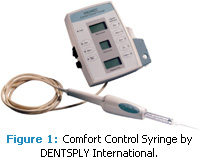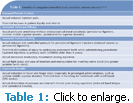
High Tech Pain Relief
Reap the benefits of computer-controlled local anesthesia delivery.
The 21st century clinician is surrounded by technological choices. An electronic, computerized, and/or digital solution can be found for nearly every common task today. Dentistry, in particular, has benefited from numerous technological advances. Oral health professionals store patient records electronically, capture radiographs digitally, and use laser fluorescence to detect caries and subgingival calculus deposits. Local anesthesia delivery has also gone high tech with an important and well-assessed innovation that has been available since the late 1990s—the computer-controlled local anesthetic delivery (C-CLAD) device.
The most commonly used C-CLAD devices in the United States are the Comfort Control™ Syringe (DENTSPLY International) and the STA Single Tooth Anesthesia System® (Milestone Scientific Inc). Both electronic instruments are preprogrammed to deliver local anesthetic drugs in a slow and controlled manner as alternatives to traditional manual syringes.
The Comfort Control Syringe (CCS) system features a two-stage delivery system that begins at a specified slow rate to minimize discomfort (Figure 1). After 10 seconds, the CCS automatically increases the injection rate for the technique selected. Five injection technique rates are preprogrammed into the device. The CCS uses standard dental local anesthetic needles and cartridges, as well as proprietary
single-use cartridge sheaths that attach directly to the motor handpieces. The device is activated by controls on the motor handpiece and includes an optional aspiration function.
The most recent innovation in C-CLAD technology is the Dynamic Pressure-Sensing® (DPS) feature of the STA instrument (Figure 2). DPS uses patented technology to provide realtime pressure feedback (at the needle tip within tissues) when performing an intraligamentary injection.1-3 Audible and visible signals aid the clinician while guiding the needle to the appropriate location. The DPS system also maintains a specified range of pressures for safe and successful intraligamentary injections.
The STA and CCS differ in that the STA uses several fixed flow rates that are ooperator-controlled while the CCS unit is automatically programmed to increase the flow rate after 10 seconds. This may be a consideration for highly sensitive patients when clinicians wish to maintain a slower rate of delivery throughout the injection or alter the flow rates during an injection. Aspiration functions are foot operated in the STA device and hand operated in the CCS device.

Increased Patient Comfort
C-CLAD has established an impressive record of patient comfort, particularly for palatal injections. Table 1 lists additional benefits.2,4-10 Both dental and medical studies have reported improved levels of pain control when using C-CLAD devices vs traditional syringes.4,5,11,12 The ability to consistently maintain slow, safe deposition rates is one factor that improves injection comfort with C-CLAD. Slow, controlled delivery rates correlate to reduced pain perception in adults and fewer pain-related disruptions in children.8
The rapid onset associated with the periodontal ligament (PDL) technique is also quite useful in difficult-to-anesthetize teeth and in supplemental injections when field or block anesthesia is incomplete for individual teeth.1,2
Reduced post-operative pain may be attributed to the controlled rates of C-CLAD (0.007 ml/second with CCS and 0.005 ml/second with STA System) with associated constant and reduced electronically-achieved fluid pressures.3,13 Table 2 provides a comparison of pressures during PDL injections between two manual syringes and a C-CLAD device.13 Clinician gender may have a measurable impact on fluid pressures during intraoral injections with manual syringes.13 Not surprisingly, women tend to generate lower pressures than men.13 The extent of the variation between women and men is reflected in the wide pressure ranges for manual devices shown in Table 2.13
Increased Technique Efficacy
Studies have reported enhanced technique effectiveness, particularly in palatal and PDL injections, when using C-CLAD devices. A recent study compared the efficacy of the anterior middle superior alveolar (AMSA) nerve block with the infraorbital nerve block exclusively performed with C-CLAD. The study found that success rates of the AMSA nerve block in the lateral incisor to second premolar region were 75% to 85.7%. Not only are these rates more successful than the infraorbital block’s, they are also comparable to accepted success rates for inferior alveolar nerve blocks.7
This study considered only pulpal anesthesia and did not comment on a significant additional benefit of the AMSA: widespread palatal anesthesia from the same injection. In other words, usually one injection is necessary to provide pulpal and palatal soft tissue anesthesia. Other techniques require multiple injections in order to achieve the same extent of anesthesia.1,14 This widespread soft tissue anesthesia is of particular value to dental hygienists.
Increased Technique Safety
Involuntary needle movement can hinder the ability to maintain an aspiration position while depositing anesthesia.6 Research suggests that needle position may be significantly easier to maintain when using C-CLAD.6 Currently, there is only limited evidence that aspiration is more effective with computer-controlled syringes, however, it may be easier to maintain needle positions with C-CLAD devices compared to manual syringes.
An ongoing concern when using PDL injections in children with primary and mixed dentitions is the possibility of injury to underlying permanent teeth from PDL injection pressures. Recent literature found that the administration of PDL injections with C-CLAD around primary teeth (older than 4 years with underlying permanent teeth) does not increase the risk of damage to the underlying permanent dentition.15 Evidence was collected while using the slower C-CLAD rate. Data were collected after PDL injections around 166 primary teeth with underlying permanent teeth. Manual standard and high-pressure syringes were not studied and the evidence should not be applied to those devices.
Ergonomic Benefits
C-CLAD devices also provide ergonomic benefits for clinicians.9 Some clinicians with cumulative trauma injuries have noticed less hand fatigue and strain while using C-CLAD. Literature supports the ergonomic efficacy of C-CLAD in many circumstances, including injections that require prolonged administrations of anesthetic solution.1,4 This can lead to stresses, most frequently experienced during injections in the palate or PDL, where fibrous resistance to deposition can place exceptional strain on hands and fingers.1 These traumas may occur multiple times during a busy day. C-CLAD makes aspiration tasks easier for individuals with small hands and those with a history of cumulative trauma injury. Neither the CCS nor the STA relies on pull-back pressure applied with the thumb. Aspiration is triggered either by a foot pedal or a button on the device’s handpiece.
Practice Building
The use of these devices in medical specialties, such as proctology, dermatology, and orthopedics, is increasing due to reports of reduced pain during injections and because of the newer technology’s ability to identify specific tissues.5,12 Dentistry runs the risk of being left behind in the use of a technology that was originally developed to provide the best pain control possible for dental patients. As patients become aware of technologies, such as C-CLAD, that offer significant advantages, they may seek out practices that use these devices and, thus, refer family and friends.
REFERENCES
- Bassett KB, DiMarco AC, Naughton DK. Local Anesthesia for Dental Professionals. Upper Saddle River, NJ: Pearson Education; 2010.
- Ferrari M, Crysanti C, Vichi A, Goracci S. Efficacy of the Computer-Controlled Injection System STA, the Ligmaject, and the dental syringe for intraligamentary anesthesia in restorative patients. International Dentistry SA. 2004; 11(1):4-11.
- Hochman MN. (2007) Single-tooth anesthesia: pressure-sensing technology provides innovative advancement in the field of dental local anesthesia. Compend Contin Educ Dent. 2007;28:186-188, 190, 192-193.
- Loomer PM, Perry DA. Computer-controlled versus syringe delivery of local anesthetic injections for therapeutic scaling and root planning. J Am Dent Assoc. 2004;135:358-365.
- Anderson ZN, Podnos SM, Shirley-King R. Patient satisfaction during the administration of local anesthetic using a computer controlled local anesthetic delivery system. Dermatol Nurs. 2003;15:329- 330, 392.
- Daubländer M. Video monitoring of aspiration with 5 injection systems in an in vitro model. Paper presented at: First Annual International Computer-Controlled Local Anesthetic Delivery Symposium; February 8-10, 2008; New Orleans.
- Corbett IP, Jaber AA, Whitworth JM, Meechan JG. A comparison of the anterior middle superior alveolar nerve block and Infraorbital nerve block for anesthesia of maxillary anterior teeth. J Am Dent Assoc. 2010;141:1442.
- Gibson RS, Allen K, Hutfless S, Beiraghi S. The Wand vs. traditional injections: a comparison of pain related behaviors. Pediatr Dent. 2000;22:458-462.
- Murphy DC. Ergonomics and the Dental Care Worker. Washington, DC: American Public Health Association; 1998:180-181.
- Hochman MN, Friedman MJ. In vitro study of needle deflection: a linear insertion technique versus a bidirectional rotation insertion technique. Quintessence Int. 2000;31:737-743.
- Lee S, Reader A, Nusstein J, Beck M, Weaver J. Anesthetic efficacy of the anterior middle superior alveolar (AMSA) injection. Anesth Prog. 2004;51:80-89.
- Tan PY, Vukasin P, Chin ID, et al. The WAND local anesthetic delivery system: a more pleasant experience for anal anesthesia. Dis Colon Rectum. 2001;44:686-689.
- Hochman MN, Friedman MJ, Williams W, Hochman CB. Interstitial tissue pressure associated with dental injections: a clinical study. Quintessence Int. 2006;37:469-475.
- Bassett KB, DiMarco A. Effective use of the AMSA nerve block. Dimensions of Dental Hygiene. 2010;8(7):30-32, 34.
- Ashkenazi M, Blumer S, Eli I. Effect of computerized delivery intraligamental injection in primary molars on their corresponding permanent tooth buds. Int J Paediatr Dent. 2010;20:270-275.
From Dimensions of Dental Hygiene. March 2011; 9(3): 64-66.

